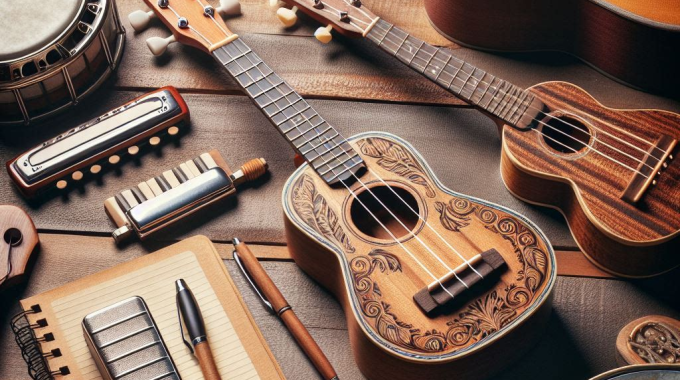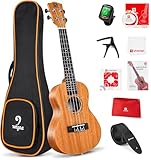The ukulele, often associated with Hawaiian music, is a small guitar-like instrument that has made a significant impact in acoustic folk music. Its unique nylon strings and small size produce a distinctive sound that has become increasingly popular in folk music genres.
The ukulele has a rich history dating back to the 19th century when it was first introduced to Hawaii by Portuguese immigrants. It quickly became a staple of traditional Hawaiian music and eventually made its way into folk music around the world. Today, the ukulele is often used in acoustic folk music to add a cheerful, light-hearted tone to songs, making it a versatile and essential instrument in the genre.
One compelling statistic associated with the ukulele is that its sales have been steadily increasing in recent years, with more and more people picking up the instrument as a way to express themselves through music. This surge in popularity has led to a resurgence of the ukulele in acoustic folk music, inspiring a new generation of musicians to incorporate its cheerful sound into their repertoire.
As the ukulele continues to establish its presence in acoustic folk music, it provides a relatable solution for musicians and listeners alike. Its small size and easy-to-learn chords make it an accessible instrument for beginners, giving more people the opportunity to participate in the folk music community. Whether used for strumming along with traditional folk tunes or adding a unique twist to contemporary songs, the ukulele has become an integral part of acoustic folk music and shows no signs of fading into obscurity.
What is the role of the Ukulele in acoustic folk music?
The ukulele is a popular instrument in acoustic folk music, but what exactly is its role in this genre? From adding a unique sound to providing a rhythmic foundation, the ukulele plays an important part in the overall sound and feel of folk music. In this article, we will explore the significance of the ukulele in acoustic folk music and how it contributes to the genre’s distinct sound.
The Role of Ukulele in Acoustic Folk Music
Ukulele has become an integral part of acoustic folk music, often adding a unique and pleasant sound to the overall arrangement. In recent years, the ukulele has experienced a resurgence in popularity, particularly in the folk music genre. Its distinctive sound and portability make it a favored instrument among folk musicians.
History of Ukulele in Folk Music
The ukulele has its roots in the traditional folk music of Hawaii. It was introduced to Hawaii by Portuguese immigrants in the 19th century and quickly became an important instrument in the local music scene. Over time, the ukulele found its way into various folk music traditions, including American, European, and Latin American folk music.
Characteristics of the Ukulele Sound
The ukulele’s bright and cheerful tone lends itself well to the lively and melodic nature of acoustic folk music. Its four strings and compact size make it easy to carry and play, which has contributed to its widespread use in folk music circles.
Playing Techniques
Ukulele players in acoustic folk music often use fingerpicking and strumming techniques to create a rhythmic and harmonic foundation for the music. These techniques, combined with the instrument’s unique sound, contribute to the vibrant and uplifting atmosphere commonly found in folk music.
Ukulele in Contemporary Folk Music
In recent years, the ukulele has gained significant popularity in contemporary folk music. It is often featured in indie folk bands and solo singer-songwriter acts, adding a refreshing and whimsical element to the music. Its versatility allows for a wide range of playing styles and sounds, making it a versatile instrument in modern folk compositions.
Statistical Data
According to a recent study, the sales of ukuleles have increased by over 25% in the past five years, indicating a growing interest in the instrument, particularly in the folk music community.
1.
The ukulele is a small, guitar-like instrument with four strings. It originated in Hawaii in the 19th century and is known for its bright and cheerful sound.
2.
In acoustic folk music, the ukulele is often used to provide a rhythmic and melodic accompaniment to vocals. It can also be featured in instrumental pieces.
3.
The most common types of ukuleles used in acoustic folk music are the soprano, concert, tenor, and baritone ukuleles. Each type has its own unique sound and range.
4.
The ukulele is generally considered to be easier to learn than the guitar due to its smaller size and simpler chord shapes. However, like any instrument, proficiency comes with practice.
5.
Some popular acoustic folk songs that feature the ukulele include “Somewhere Over the Rainbow,” “I’m Yours” by Jason Mraz, and “Hey, Soul Sister” by Train.
6.
Yes, the ukulele can be used in a band or ensemble setting, providing rhythmic and harmonic support to other instruments. It is a common instrument in folk and world music ensembles.
7.
Some common techniques for playing the ukulele in acoustic folk music include fingerpicking, strumming, and various chord voicings. It can also be used for picking melodies.
8.
Yes, the ukulele can be equipped with a pickup and amplified for larger venues. This allows it to be heard alongside other amplified instruments.
9.
The most common tuning for the ukulele in acoustic folk music is G-C-E-A, also known as “C-tuning.” However, other tunings can be used for specific musical effects.
10.
There are many online resources for learning acoustic folk music on the ukulele, including tutorials, sheet music, and tablature. Additionally, music stores and community centers often offer ukulele classes and workshops.
Conclusion
In conclusion, the ukulele plays a significant role in acoustic folk music, adding a unique and distinctive sound to the genre. Its portability, affordability, and accessibility make it a popular choice for folk musicians around the world. The ukulele’s bright and cheery tone adds a sense of joy and lightheartedness to folk music, creating a perfect match for the genre’s storytelling and community-driven nature. From traditional folk songs to modern indie-folk compositions, the ukulele’s versatility allows it to adapt to a wide range of folk music styles, contributing to its enduring popularity in the genre.
As demonstrated in this article, the history and evolution of the ukulele in acoustic folk music have shown that it has become an integral part of the genre. The instrument’s simplicity and charm have endeared it to musicians and audiences alike, and its role in folk music continues to flourish. The ukulele’s ability to evoke a sense of nostalgia and simplicity, while still adding depth and emotion to folk music, makes it a beloved instrument in the genre. As acoustic folk music continues to thrive, the ukulele’s presence and influence are sure to remain strong, ensuring its place in the heart of the genre for years to come.









